The Harpy Eagle is a fantastic bird found in the rainforests of Central and South America. With its majestic appearance and powerful hunting skills, the Harpy Eagle has fascinated people throughout history. In this blog post, we will explore the intriguing world of the Harpy Eagle, learning about its history, interesting facts, size, habitat, and classification.
The Harpy Eagle has a long and storied history, with evidence of its existence dating back millions of years. This bird has captured the imaginations of many cultures, often depicted in mythology and ancient artwork. Its large size and distinctive features have made it an icon in the bird world.
When it comes to facts, the Harpy Eagle never fails to impress. With a wingspan of up to 7 feet, it is one of the world’s largest and most powerful eagles. Its sharp nails can measure up to 5 inches, allowing it to catch and carry animals as heavy as sloths and monkeys. These impressive abilities make the Harpy Eagle a formidable predator in its rainforest habitat.
Regarding habitat, the Harpy Eagle prefers to live in undisturbed, mature forests. It requires large territories to roam and hunt, which makes deforestation a significant threat to its survival. Efforts are being made to preserve its habitat and protect this magnificent bird for future generations.
In this blog post, we have explored the history, facts, size, habitat, and classification of the Harpy Eagle. Hopefully, you have gained a deeper appreciation for this incredible bird and the importance of preserving its habitat. Stay tuned for more exciting articles on the fascinating world of animals.
History of Harpy Eagle

The Harpy Eagle is a majestic bird that has a long history. This fantastic creature can be found in the tropical rainforests of Central and South America. Its impressive size and unique features have fascinated people for many years.
Throughout history, indigenous tribes in these regions have revered the Harpy Eagle. They believed that this bird had a special connection to the spiritual world. It was often seen as a power, strength, and wisdom symbol. These tribes often depicted the Harpy Eagle in their art and folklore, passing down stories from generation to generation.
During the early colonial times, the Harpy Eagle faced a threat to its existence. European settlers viewed it as a danger to their livestock and saw it as a threat to their livelihoods. This led to the hunting and killing of many Harpy Eagles, resulting in a decline in their population. Thankfully, various conservation efforts have been implemented to protect this magnificent species from further harm in recent years.
Today, the Harpy Eagle is considered a national symbol in some countries, such as Panama and Belize. Its importance has been recognized, and steps are being taken to preserve its habitat and ensure its survival. Through education and raising awareness, people are learning about the ecological importance of the Harpy Eagle and are working towards creating a sustainable future for this remarkable bird.
The Harpy Eagle has a rich history, from being revered by ancient tribes to being celebrated as a national symbol in some countries. Despite facing threats in the past, efforts are underway to protect and preserve this magnificent bird for future generations to marvel at its beauty and importance in the ecosystem.
Importance of Harpy Eagle
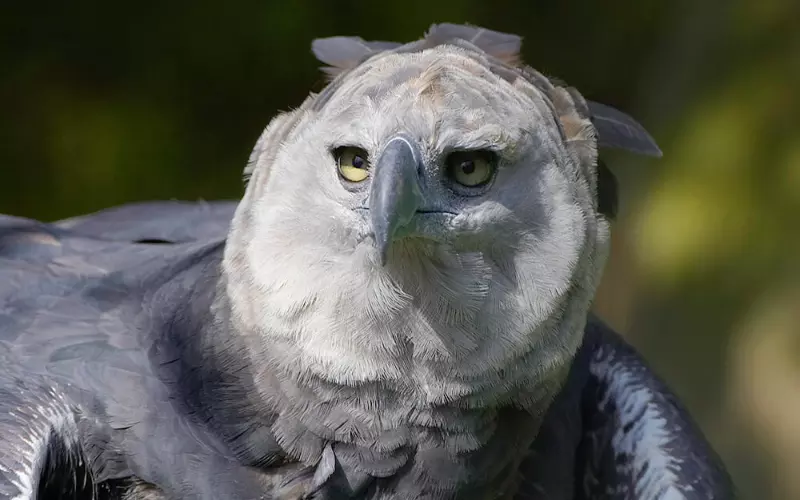
The Harpy Eagle is an incredible bird that plays a vital role in our environment. One important reason why the Harpy Eagle is so special is because it helps control other animal populations. As a top predator, it preys on smaller animals like monkeys, sloths, and rodents. Hunting these animals helps the Harpy Eagle keep their people in check. This is important because if these smaller animals become too abundant, they can cause an imbalance in the ecosystem.
Another important reason why the Harpy Eagle is significant is because it is an indicator of the health of our forests. These magnificent birds depend on large, intact forests for their survival. When we see Harpy Eagles thriving, their habitat is in good condition. However, if their numbers start declining, it could indicate that something is wrong with the forest ecosystem. Protecting the Harpy eagles and their habitat is crucial for preserving our planet’s biodiversity.
Lastly, the Harpy Eagle has cultural importance for many indigenous communities. It is considered a symbol of strength and power in some cultures. Its majestic appearance and unique characteristics make it a special bird that people worldwide admire. By conserving the Harpy Eagle, we can also help to protect the cultural heritage of these indigenous communities and ensure that future generations can appreciate the beauty and significance of this remarkable bird.
Amazing Facts About Harpy Eagle
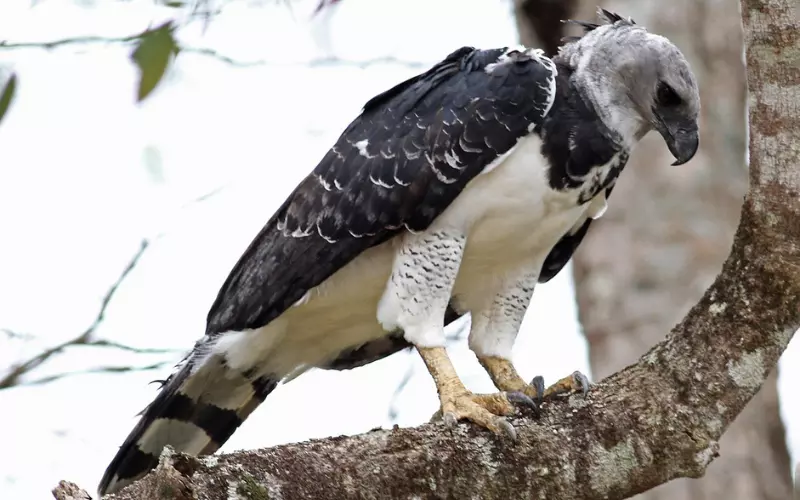
1. Harpy Eagles are one of the world’s largest and most powerful birds of prey.
2. They can be found in the tropical rainforests of Central and South America.
3. These majestic birds have a wingspan of up to 7 feet (2 meters).
4. Harpy Eagles are known for their distinctive and prominent crests on their heads.
5. They have strong and sharp talons, measuring up to 5 inches (13 centimetres) in length.
6. Harpy Eagles mainly feed on monkeys, sloths, and other tree-dwelling animals.
7. These birds are excellent hunters, capable of capturing prey as heavy as 17.5 pounds (8 kilograms).
8. They have incredibly keen eyesight, allowing them to spot prey from great distances.
9. Harpy Eagles build large nests, often using branches and leaves, high up in the trees.
10. Females are usually larger, weighing 15-20 pounds (7-9 kilograms), while males weigh around 9-13 pounds (4-6 kilograms).
11. Their breeding cycle is slow, with females producing only one or two chicks every two to three years.
12. Both parents participate in raising and feeding their chicks for a relatively long period.
13. Harpy Eagles have a lifespan of up to 25-35 years in the wild.
14. Their population is declining due to habitat loss and illegal hunting, making them a vulnerable species.
15. Conservation efforts are being made to protect these magnificent birds and their rainforest habitats.
Can we keep Harpy Eagle as our Pet?
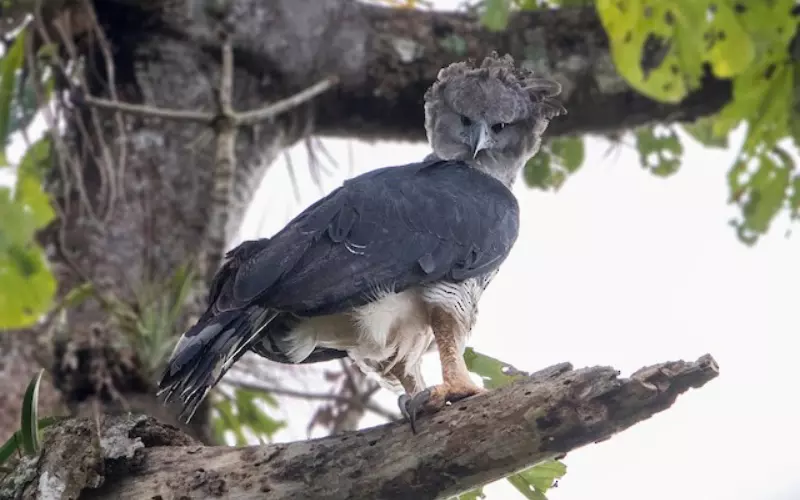
The Harpy Eagle bird is a magnificent creature found in the rainforests of Central and South America. With its large size, impressive wingspan, and powerful talons, it is a sight to behold. However, sadly, we cannot keep Harpy Eagles as pets.
Firstly, it is vital to understand that the Harpy Eagle is not an appropriate choice for a pet. These birds are meant to live freely in their natural habitats. They require large territories to hunt and fly, which cannot be provided in a typical household. Attempting to keep a Harpy Eagle as a pet would be unfair to the bird and put the owner and others at risk due to their large size and predatory nature.
Furthermore, it is essential to note that the Harpy Eagle population is declining and risks becoming extinct. Deforestation, habitat loss, and illegal hunting are the major factors impacting their numbers. These incredible birds play a crucial role in maintaining the delicate balance of ecosystems, which is essential for survival. Therefore, instead of keeping them as pets, we should focus on conserving their natural habitats, raising awareness about their importance, and supporting efforts to protect them from extinction.
It is not feasible or ethical to keep Harpy Eagles as pets. These magnificent birds belong in the wild, where they can thrive and fulfil their ecological roles. Our responsibility is to ensure their survival by preserving their habitats and raising awareness about their importance. Let us appreciate the beauty of Harpy Eagles from a distance and work together to safeguard their future.
Size of Harpy Eagle
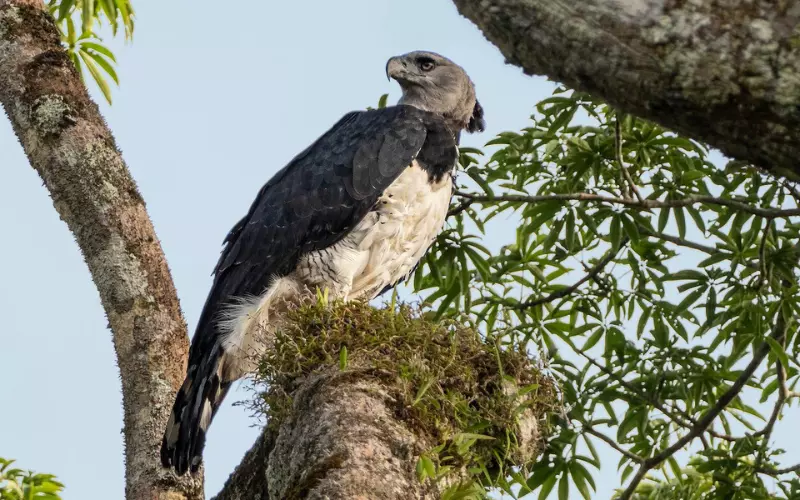
The Harpy Eagle bird is one of the world’s largest and most powerful eagles. It is famous for its impressive size and strength. A fully-grown Harpy Eagle can measure up to 3 feet in height and have a wingspan of about 7 feet! That’s almost as tall as a grown-up person and as wide as a small car!
Not only is the Harpy Eagle big, but it also weighs quite a lot. This mighty bird can weigh up to 20 pounds when fully grown. To give you an idea, that’s as heavy as a bowling ball! Imagine carrying around a bowling ball on your arm all day long. That’s how strong and sturdy the Harpy Eagle is.
Despite its enormous size, the Harpy Eagle is a skilled hunter and can move quickly through the forest in search of its prey. Its powerful nails, as long as bears’ claws, help it catch its meals. The Harpy Eagle mainly feeds on small mammals like sloths, monkeys, and deer. It has excellent eyesight, which allows it to spot prey from high up in the trees.
The Harpy Eagle is one of the largest and strongest eagles in the world. Its massive size and incredible wingspan make it a true marvel of nature. As we learn more about these majestic birds, we can appreciate their importance in maintaining the delicate balance of our ecosystems.
Habitat of Harpy Eagle

Harpy eagles are vast and powerful birds that live in the rainforests of Central and South America. These majestic birds prefer to make their homes in tall, dense trees in undisturbed and remote jungle areas. The habitat of the harpy eagle is an essential factor for its survival, as it provides the necessary resources and shelter for the bird to thrive.
Harpy eagles can be found soaring high above the treetops in these rainforest habitats, using their keen eyesight to locate their prey. With their solid wings and sharp nails, they can swiftly capture their preferred food, which includes monkeys, sloths, and other small animals. The dense canopy of the forest provides ideal coverage for these birds to quietly approach their prey without being detected.
The tall trees in the harpy eagle’s habitat also offer them a safe place to build their nests. These nests, known as eyries, are constructed high up in the branches, offering protection from predators and other disturbances. The large nests can measure up to six feet in diameter, providing ample space for the female to lay eggs and raise her young.
The habitat of the harpy eagle is filled with rich biodiversity, with a wide variety of plant and animal species. This diversity allows the eagle to thrive, as it can find abundant prey and food sources. However, due to deforestation and habitat destruction, the population of harpy eagles is declining. We need to protect their habitat and work towards preserving the rainforests for the survival of these magnificent birds and the entire ecosystem.
Evolution of Harpy Eagle
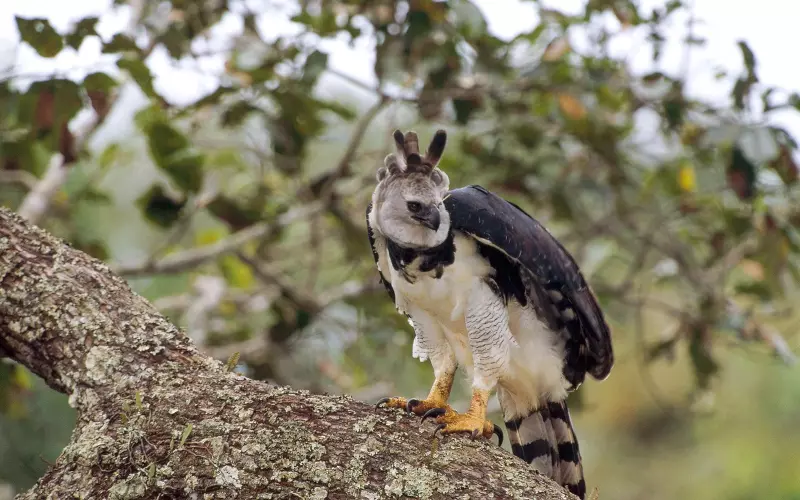
The mighty Harpy Eagle, a bird famous for its strength and beauty, has evolved over millions of years to become the impressive creature we know today. In the ancient forests of South America, where the Harpy Eagle calls home, its ancestors were small and timid birds. They adapted to their surroundings, growing larger and more powerful as time passed.
During the time of the dinosaurs, the Harpy Eagle’s ancestors were already soaring through the skies. They had long, sharp nails, which helped catch small prey like lizards and birds. As the dinosaurs disappeared, the Harpy Eagles faced new challenges and opportunities. They evolved to have keen eyesight, allowing them to spot their prey above the forests. With this advantage, they could swoop down incredibly quickly and snatch up their victims in their powerful talons.
Over the centuries, the Harpy Eagles continued to evolve. They grew larger, with some adults reaching almost one meter in height. Their wingspan expanded to an incredible two meters, making them one of the world’s most giant birds of prey. This expansion allowed them to glide effortlessly through the dense rainforests, where they hunted monkeys and sloths for their meals.
The Harpy Eagle’s evolution is a remarkable story of how a small, timid bird became a powerful and majestic predator. From its humble beginnings in the ancient forests of South America, the Harpy Eagle transformed into a formidable creature capable of capturing prey with its sharp talons and exceptional eyesight. Even today, it remains a symbol of strength and beauty in the vast rainforests it calls home.
Classification of Harpy Eagle

The Harpy Eagle is a fascinating bird that belongs to the classification of birds known as Accipitridae. This family includes about 240 species of birds of prey, including hawks and eagles. The Harpy Eagle is one of the giant and most potent eagles, and it is found in the tropical rainforests of Central and South America.
Regarding its scientific classification, the Harpy Eagle is known as Harpia Harpyja. The genus name Harpia is derived from the Greek word ‘harpē’, which means ‘snatcher’, reflecting the bird’s hunting abilities. The species name Harpyja references the Greek mythological creature, the Harpy, which was a half-human, half-bird monster. This shows the mighty and majestic nature of the Harpy Eagle.
The Harpy Eagle has a distinct appearance with its large size, muscular build, and striking facial features. It has a wingspan reaching up to 2 meters and powerful paws that can be as long as a grizzly bear’s claws! Its plumage is predominantly grey, with a black chest and a white belly. Its head is adorned with prominent grey feathers that give it a distinctive look.
The Harpy Eagle belongs to the Accipitridae family, and its scientific name is Harpia harpyja. It is known for its large size, robust build, and striking appearance. This bird is a marvel of nature and a majestic sight to behold in the tropical rainforests of Central and South America.
Different Types of Harpy Eagle
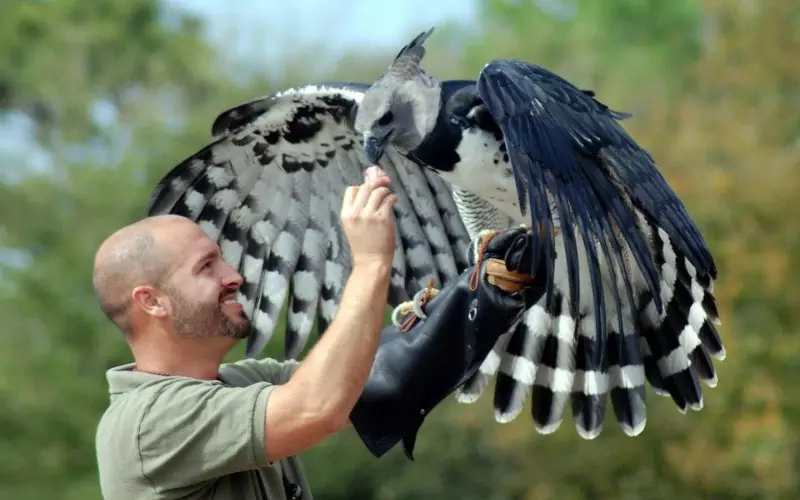
1. The Harpy Eagle (Harpia harpyja) is one of the world’s largest and most powerful birds of prey. It has a wingspan of up to 7 feet, and its height can reach 3 feet. These majestic birds are found in the Americas, mainly in tropical rainforests.
2. Harpy Eagles have a unique appearance, with a crown of feathers on their head resembling a lion’s mane. Their upper body and wings have striking grey feathers, while their belly is white. These features help them blend into their dense forest habitats.
3. These birds are skilled hunters and feed on medium-sized mammals such as sloths, monkeys, and even small deer. Their solid and sharp nails allow them to grasp and carry prey weighing up to 20 pounds.
4. Harpy Eagles are known for their excellent vision and hearing abilities. Their large eyes enable them to spot prey far away, while their broad wings and long tails help them navigate through dense forests with agility and precision.
5. These birds have a low reproductive rate, typically laying only one or two eggs every two to three years. The incubation period can last for around 50 to 56 days, and both parents contribute to caring for the chicks until they become independent.
6. deforestation and habitat loss have significantly impacted the Harpy Eagle population. They rely on large, undisturbed forest areas for hunting and nesting, and their numbers have decreased due to human activities and land conversion.
7. Harpy Eagles play a vital role in their ecosystems by regulating prey populations, thus contributing to a balanced ecosystem. Their presence helps control the population of animals such as monkeys, sloths, and rodents.
8. Conservation efforts have been implemented to protect and preserve the Harpy Eagle population. Initiatives focus on creating protected areas and raising awareness about conserving their natural habitats to ensure survival.
9. Harpy Eagles have been revered and hold cultural significance in indigenous communities throughout their range. They are often seen as symbols of strength and power, and their images are frequently depicted in local arts and crafts.
10. These birds have captivated many people due to their majestic appearance and impressive hunting abilities. They have become a symbolic and iconic species, representing the beauty and diversity of tropical rainforests and inspiring conservation efforts.
Geographical Presence of Harpy Eagle

The Harpy Eagle bird is found in the tropical rainforests of Central and South America. These magnificent creatures inhabit countries like Mexico, Belize, Guatemala, Honduras, Nicaragua, Costa Rica, Panama, Venezuela, Colombia, Ecuador, Peru, Bolivia, and Brazil. Their large and robust build allows them to soar through the dense rainforest canopies with great ease, using their strong talons to snatch prey from the treetops. The Harpy Eagle’s impressive wingspan, reaching 7 feet, contributes to their graceful flight and hunting abilities.
However, the Harpy Eagle is not found in regions outside the Americas. You won’t see this bird in North America, Europe, Asia, Africa, or Australia. The unique rainforest environment, with its abundant prey and tall trees for nesting, provides the perfect habitat for this awe-inspiring bird. Its absence in other regions is due to the specific requirements and adaptations the Harpy Eagle has developed over time to thrive in its native habitat.
The Harpy Eagle, with its distinctive grey plumage and striking facial features, is an iconic bird of the Americas. Despite their large size and breathtaking appearance, they are unfortunately classified as near-threatened by the International Union for Conservation of Nature (IUCN). Their population decline is mainly attributed to habitat loss caused by deforestation and illegal hunting. Efforts are being made to protect their remaining rainforest homes and raise awareness about preserving these incredible birds for future generations.
Scientific Name of Harpy Eagle

The scientific name of the Harpy Eagle bird is Harpia harpyja. This majestic bird is known for its large size and robust build. It is one of the world’s most giant and potent eagles, with a wingspan of up to 7 feet and around 20 pounds.
The Harpy Eagle is found in the tropical rainforests of Central and South America. It has a distinctive appearance: a grey body, black head feathers resembling a crest, and piercing yellow eyes. Its legs are thick and robust, and its sharp, curved talons enable it to catch and grip its prey securely.
This incredible bird is an apex predator, meaning it is at the top of the food chain in its habitat. Its diet consists mainly of mammals, such as monkeys, sloths, and even small deer. The Harpy Eagle is an expert hunter, using its excellent eyesight and mighty wings to soar through the forest and ambush its prey from above.
The scientific name of the Harpy Eagle bird is Harpia harpyja. This fantastic creature is known for its large size, robust build, and impressive hunting skills. It plays a crucial role in the ecosystem by controlling the population of small mammals in its habitat. The Harpy Eagle is a remarkable bird that deserves our admiration and protection.
Diet of Harpy Eagle

The Harpy Eagle, a majestic bird found in the rainforests of Central and South America, has a diet that mainly consists of mammals. These incredible creatures have sharp, powerful claws that allow them to catch animals such as monkeys, sloths, and even small deer. With their keen eyesight and strong wings, Harpy Eagles are skilled hunters.
Harpy Eagles perch high up in the trees to catch their prey, patiently waiting for the right moment to strike. Once they spot their target, they swoop down swiftly, using their sharp talons to grab onto the unfortunate animal. They can carry their prey back to their nest to enjoy a meal with their firm grip.
Although mammals form the main part of their diet, Harpy Eagles are opportunistic eaters. This means that they will also consume other types of food, such as birds, reptiles, and even insects if they find them nearby. These incredible predators have an essential role in maintaining the balance of their ecosystem by keeping the population of certain animals in check.
The Harpy Eagle is an impressive bird with a varied diet. From mammals to birds and reptiles, these powerful birds can hunt and consume a wide range of prey. Their hunting skills and strong paws enable them to catch and carry food back to their nests. By hunting different animals, the Harpy Eagle is essential in maintaining the delicate ecosystem of the rainforests they call home.
Locomotion of Harpy Eagle
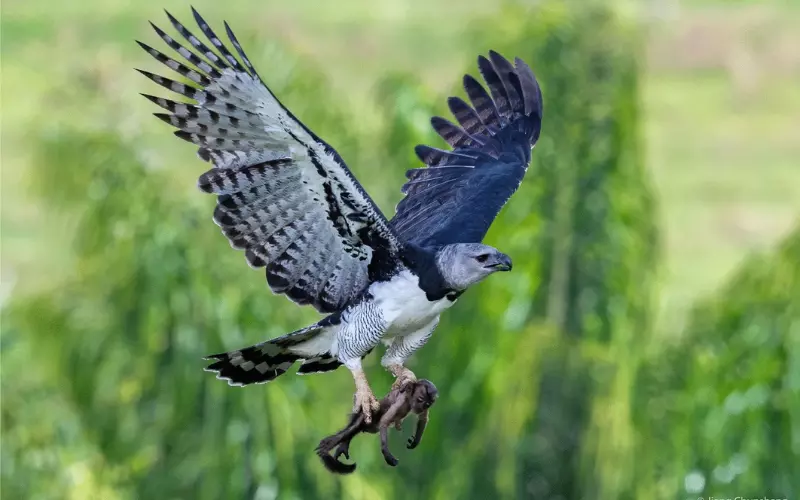
The Harpy Eagle is a magnificent bird known for its powerful and impressive moving method. With its large wingspan, reaching up to 7 feet, this bird can soar high in the sky. It uses its solid wings and tail feathers to navigate the air gracefully and efficiently. The Harpy Eagle is also known for its incredible agility. It can quickly change directions while in flight, making it an expert hunter. With its sharp eyesight, this bird can spot its prey from great heights, dive rapidly, and snatch it with its strong talons.
Not only is the Harpy Eagle skilled in the air, but it is also capable of moving swiftly on land. It has strong legs and feet with sharp talons that allow it to grip onto tree branches securely. This is helpful when the bird needs to perch or catch its prey. It can move along tree branches effortlessly, using its wings for balance. The Harpy Eagle’s locomotion is marvellous, enabling it to quickly conquer the skies and the land.
Social and Sexual Behaviour of Harpy Eagle

The social and sexual behaviour of the Harpy Eagle bird is quite fascinating. These majestic birds usually live alone or in pairs, forming a monogamous bond. Monogamy means they have only one partner throughout their lifetime, just like humans who marry and stay together.
Regarding mating, the female Harpy Eagle lays only one or two eggs simultaneously. The male and female take turns caring for the eggs and raising the chicks once they hatch. This shows that they share the responsibility of parenting. Isn’t that amazing?
But there’s more! Harpy Eagles communicate with each other through sounds and body postures. They can make loud, high-pitched calls to attract a mate or mark their territory. Sometimes, they also use these calls to warn other birds to stay away. Communication is essential for any species and is crucial to their social and sexual behaviour.
In a nutshell, Harpy Eagles are monogamous birds, meaning they mate for life. Both parents take care of their young ones, and they communicate with each other using various sounds and body movements. Their social and sexual behaviour shows us the importance of commitment, shared responsibilities, and effective communication.
Reproduction and Lifecycle of Harpy Eagle
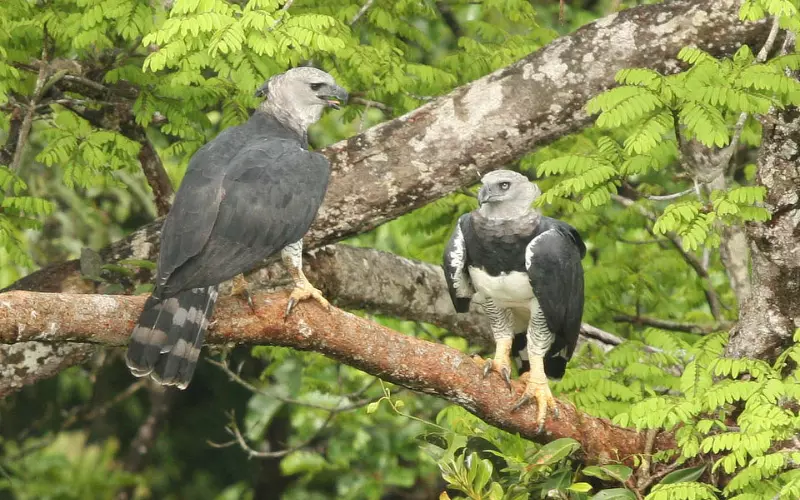
Harpy eagles are fascinating birds with interesting reproduction and life cycles. These magnificent creatures undergo a series of stages to ensure the survival and growth of their species.
The life cycle of a harpy eagle begins with the mating process. During this time, the male and female display elaborate courtship, including vocalizations and aerial acrobatics. Once they have formed a pair bond, the female usually lays one or two eggs in a large stick nest high up in the trees. Both parents take turns incubating the eggs, keeping them warm until they are ready to hatch.
After about a month, the eggs finally hatch, revealing tiny, helpless chicks. The parents are dedicated caregivers, providing food and protection to their young. As the chicks grow, they go through various developmental stages. They start with a fluffy, downy covering, and as they mature, they develop feathers. Eventually, they gain enough strength to stand and move around the nest, preparing for their first flight.
Once the chicks reach a certain age, usually four to six months, they are ready for their maiden flight. This can be a daunting task, as it requires them to leave the safety of the nest and venture into the world. The parents play a vital role during this period, teaching the fledglings essential hunting and survival skills. The young eagles become independent with time, leaving their parents’ territory to find their mate and start the cycle anew.
A harpy eagle’s reproductive and life cycle starts with courtship, followed by egg-laying, incubation, hatching, chick upbringing, and finally, independence. Each stage is crucial for their species’ survival and continuation, showcasing these majestic birds’ remarkable resilience and dedication.
Threats to Harpy Eagle

The magnificent Harpy Eagle bird faces several threats that put its survival at risk. One big threat is habitat loss. As humans expand their cities, cut down trees, and clear forests for agriculture, the Harpy Eagle loses its homes. Forest destruction makes it difficult for these birds to find food and build their nests, which leads to a decline in their population.
Another threat to Harpy Eagles is hunting. Some people hunt these beautiful birds for their feathers and body parts. They are also killed because they are seen as dangerous to livestock, such as chickens and small farm animals. This hunting and the destruction of their habitats dramatically impact the number of Harpy Eagles left worldwide.
Lastly, pollution is a problem for Harpy Eagles. Pesticides and other agricultural chemicals can contaminate these birds’ water and food sources. When they consume polluted prey, it can harm their health and reproductive abilities. Pollution affects the overall well-being of the Harpy Eagle population and can lead to a decline in their numbers.
To protect the Harpy Eagle bird, it is crucial to preserve their habitats by preventing deforestation. Creating protected areas where these birds can live undisturbed is essential. Education and awareness campaigns can help people understand the importance of these magnificent birds and discourage hunting. Additionally, efforts should be made to reduce pollution and the use harmful chemicals in agriculture to safeguard the health of the Harpy Eagles and their environment. By taking these actions, we can help ensure the survival of the Harpy Eagle for future generations to admire and appreciate.
The population of Harpy Eagles

The population of the Harpy Eagle bird is estimated to be around 20,000 individuals. These magnificent birds live in the tropical rainforests of Central and South America. The Harpy Eagle is one of the world’s most giant and most potent eagles, known for its distinct crest of feathers on its head.
Unfortunately, if the Harpy Eagle were to become extinct, it would mean that no more of these birds are left in the wild. Extinction happens when a species disappears entirely from the Earth. This can occur for various reasons, such as habitat loss, hunting, or environmental changes. When a species becomes extinct, no more individuals are left alive anywhere.
The Harpy Eagle is not currently extinct, but it is considered to be near-threatened. This means they risk becoming endangered if their population continues declining. Protecting these magnificent birds and their rainforest habitats is essential to ensure their survival for future generations.
Conclusion
The majestic Harpy Eagle has a long history and fascinating facts, making it an incredible creature. This fantastic bird is known for its impressive size, unique habitat, and exciting classification. Let’s dive deeper into these aspects and learn more about this extraordinary animal.
Firstly, the Harpy Eagle is one of the most giant birds of prey in the world, growing to a height of up to 3.5 feet and having a wingspan of 6 feet. Its sheer size is awe-inspiring and helps it to become a skilled hunter. This bird is found in the dense rainforests of Central and South America, making the canopy its home. It prefers living high above the ground to have a clear view of its surroundings and spot its prey, mainly small mammals and birds.
Secondly, the Harpy Eagle belongs to the classification of birds known as raptors. Raptors are prey birds with sharp beaks, powerful talons, and excellent eyesight. They are known for their hunting skills and ability to swoop down on their prey with incredible precision. The Harpy Eagle’s robust build and sharp talons perfectly fit this description.
The Harpy Eagle is a remarkable bird that captivates us with its size, habitat, and classification. This awe-inspiring creature showcases the marvels of nature and reminds us of the diversity of life on our planet. As we continue to learn about different animals, it’s important to remember and appreciate the incredible qualities and characteristics that make each species unique.
Frequently Asked Questions about Harpy Eagle (FAQ’s)
What is a Harpy Eagle?
The Harpy Eagle is a large and powerful bird of prey in the Americas.
Where does the Harpy Eagle live?
The Harpy Eagle is found in the tropical rainforests of Central and South America.
How big can a Harpy Eagle get?
Harpy Eagles can reach a wingspan of up to 7 feet and weigh up to 20 pounds.
What do Harpy Eagles eat?
Harpy Eagles feed on tree-dwelling mammals such as sloths, monkeys, and small rodents.
Are Harpy Eagles endangered?
Harpy Eagles are classified as near-threatened due to habitat loss and hunting.
How do Harpy Eagles hunt?
Harpy Eagles are known for their aerial hunting skills, using their keen eyesight to spot prey while soaring through the forest canopy.
What is the lifespan of a Harpy Eagle?
Harpy Eagles have an average lifespan of about 25 to 35 years in the wild.
Are Harpy Eagles social birds?
Harpy Eagles are typically solitary birds, only coming together for breeding purposes.
How do Harpy Eagles communicate?
Harpy Eagles communicate through various vocalizations, including screeches, whistles, and bill snaps.
What is unique about the Harpy Eagle’s appearance?
The Harpy Eagle has a large, crested head with distinctive facial feathers, giving it a unique and striking appearance.
Do Harpy Eagles have any predators?
Adult Harpy Eagles have few natural predators, but their eggs and young may be preyed upon by other large predators like snakes and other birds.
How many eggs does a Harpy Eagle lay?
A female Harpy Eagle typically lays one or two eggs, with an incubation period of about 56 days.
How long does it take for a Harpy Eagle chick to fledge?
Harpy Eagle chicks fledge or leave the nest at around 6 to 7 months of age.
Can Harpy Eagles be kept as pets?
No, Harpy Eagles cannot be kept as pets as they are protected species and require specific habitats and care.
Do Harpy Eagles play a role in their ecosystem?
Yes, Harpy Eagles are important apex predators in their ecosystem, regulating prey populations and maintaining the balance of the rainforest.

Hey there, I’m Kristen Haudenschild! I’m like a superhero for animals and people.
I work as a Dependable Hard Working Supervisor, which means I help both people and animals grow and learn. I did my school at OdySea Aquarium and Georgia Southern University in Tempe, Arizona. That’s where I learned all about animals, and guess what? I’m fascinated by them!
I even write cool articles about animals. My job history includes being an Animal Trainer and a Marine Mammal Trainer II at OdySea Aquarium. I’ve also been a Senior Animal Care Specialist and an Animal Care Specialist 2.
I love exploring animals and am always ready to help others learn more about them. So, if you ever need info about animals, give me a shout!












